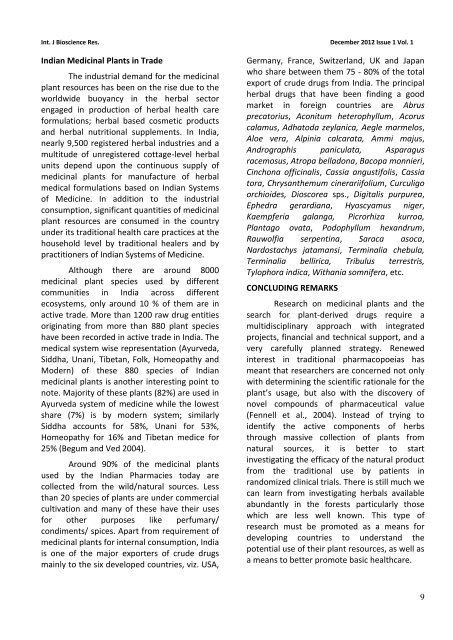indian medicinal plants as a source of therapeutic - BRT Publishers
indian medicinal plants as a source of therapeutic - BRT Publishers
indian medicinal plants as a source of therapeutic - BRT Publishers
Create successful ePaper yourself
Turn your PDF publications into a flip-book with our unique Google optimized e-Paper software.
Int. J Bioscience Res. December 2012 Issue 1 Vol. 1<br />
Indian Medicinal Plants in Trade<br />
The industrial demand for the <strong>medicinal</strong><br />
plant re<strong>source</strong>s h<strong>as</strong> been on the rise due to the<br />
worldwide buoyancy in the herbal sector<br />
engaged in production <strong>of</strong> herbal health care<br />
formulations; herbal b<strong>as</strong>ed cosmetic products<br />
and herbal nutritional supplements. In India,<br />
nearly 9,500 registered herbal industries and a<br />
multitude <strong>of</strong> unregistered cottage-level herbal<br />
units depend upon the continuous supply <strong>of</strong><br />
<strong>medicinal</strong> <strong>plants</strong> for manufacture <strong>of</strong> herbal<br />
medical formulations b<strong>as</strong>ed on Indian Systems<br />
<strong>of</strong> Medicine. In addition to the industrial<br />
consumption, significant quantities <strong>of</strong> <strong>medicinal</strong><br />
plant re<strong>source</strong>s are consumed in the country<br />
under its traditional health care practices at the<br />
household level by traditional healers and by<br />
practitioners <strong>of</strong> Indian Systems <strong>of</strong> Medicine.<br />
Although there are around 8000<br />
<strong>medicinal</strong> plant species used by different<br />
communities in India across different<br />
ecosystems, only around 10 % <strong>of</strong> them are in<br />
active trade. More than 1200 raw drug entities<br />
originating from more than 880 plant species<br />
have been recorded in active trade in India. The<br />
medical system wise representation (Ayurveda,<br />
Siddha, Unani, Tibetan, Folk, Homeopathy and<br />
Modern) <strong>of</strong> these 880 species <strong>of</strong> Indian<br />
<strong>medicinal</strong> <strong>plants</strong> is another interesting point to<br />
note. Majority <strong>of</strong> these <strong>plants</strong> (82%) are used in<br />
Ayurveda system <strong>of</strong> medicine while the lowest<br />
share (7%) is by modern system; similarly<br />
Siddha accounts for 58%, Unani for 53%,<br />
Homeopathy for 16% and Tibetan medice for<br />
25% (Begum and Ved 2004).<br />
Around 90% <strong>of</strong> the <strong>medicinal</strong> <strong>plants</strong><br />
used by the Indian Pharmacies today are<br />
collected from the wild/natural <strong>source</strong>s. Less<br />
than 20 species <strong>of</strong> <strong>plants</strong> are under commercial<br />
cultivation and many <strong>of</strong> these have their uses<br />
for other purposes like perfumary/<br />
condiments/ spices. Apart from requirement <strong>of</strong><br />
<strong>medicinal</strong> <strong>plants</strong> for internal consumption, India<br />
is one <strong>of</strong> the major exporters <strong>of</strong> crude drugs<br />
mainly to the six developed countries, viz. USA,<br />
Germany, France, Switzerland, UK and Japan<br />
who share between them 75 - 80% <strong>of</strong> the total<br />
export <strong>of</strong> crude drugs from India. The principal<br />
herbal drugs that have been finding a good<br />
market in foreign countries are Abrus<br />
precatorius, Aconitum heterophyllum, Acorus<br />
calamus, Adhatoda zeylanica, Aegle marmelos,<br />
Aloe vera, Alpinia calcarata, Ammi majus,<br />
Andrographis paniculata, Asparagus<br />
racemosus, Atropa belladona, Bacopa monnieri,<br />
Cinchona <strong>of</strong>ficinalis, C<strong>as</strong>sia angustifolis, C<strong>as</strong>sia<br />
tora, Chrysanthemum cinerariifolium, Curculigo<br />
orchioides, Dioscorea sps., Digitalis purpurea,<br />
Ephedra gerardiana, Hyoscyamus niger,<br />
Kaempferia galanga, Picrorhiza kurroa,<br />
Plantago ovata, Podophyllum hexandrum,<br />
Rauwolfia serpentina, Saraca <strong>as</strong>oca,<br />
Nardostachys jatamansi, Terminalia chebula,<br />
Terminalia bellirica, Tribulus terrestris,<br />
Tylophora indica, Withania somnifera, etc.<br />
CONCLUDING REMARKS<br />
Research on <strong>medicinal</strong> <strong>plants</strong> and the<br />
search for plant-derived drugs require a<br />
multidisciplinary approach with integrated<br />
projects, financial and technical support, and a<br />
very carefully planned strategy. Renewed<br />
interest in traditional pharmacopoei<strong>as</strong> h<strong>as</strong><br />
meant that researchers are concerned not only<br />
with determining the scientific rationale for the<br />
plant’s usage, but also with the discovery <strong>of</strong><br />
novel compounds <strong>of</strong> pharmaceutical value<br />
(Fennell et al., 2004). Instead <strong>of</strong> trying to<br />
identify the active components <strong>of</strong> herbs<br />
through m<strong>as</strong>sive collection <strong>of</strong> <strong>plants</strong> from<br />
natural <strong>source</strong>s, it is better to start<br />
investigating the efficacy <strong>of</strong> the natural product<br />
from the traditional use by patients in<br />
randomized clinical trials. There is still much we<br />
can learn from investigating herbals available<br />
abundantly in the forests particularly those<br />
which are less well known. This type <strong>of</strong><br />
research must be promoted <strong>as</strong> a means for<br />
developing countries to understand the<br />
potential use <strong>of</strong> their plant re<strong>source</strong>s, <strong>as</strong> well <strong>as</strong><br />
a means to better promote b<strong>as</strong>ic healthcare.<br />
9


